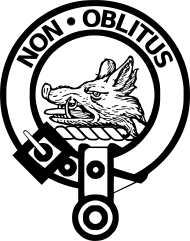Clan MacTavish
| Clan MacTavish | |||
|---|---|---|---|
| MacTamhais, MacTavish, McTavish, Mactavish, MacTavis, M‘Tavish, Thomson, Thompson | |||

Crest: boar’s head erased or langued gules" encircled by a strap and buckle (belt) bearing the motto "NON OBLITUS".
|
|||
| Motto | NON OBLITUS. | ||
| War cry | CRUACH MOR' | ||
| Profile | |||
| Region | Highland | ||
| District | Argyll | ||
| Pipe music | "MacTavish Is Here" | ||
| Chief | |||
 |
|||
| Steven Edward Dugald MacTavish of Dunardry | |||
| Chief of the Name and Arms of MacTavish, the 27th Hereditary Chief from an unbroken line | |||
| Historic seat | Castle of Dunardry | ||
|
|||
Clan MacTavish is an Ancient Highland Scottish clan.
It is commonly held that Clan MacTavish descends from Taus (Tavis) Coir, son of Colin Mael Maith and a daughter of Suibhne Ruadh (Sween the Red of Castle Sween). Nothing certain is known of Taus Coir other than he is listed in traditional genealogies. The 17th century genealogy Ane Accompt of the Genealogie of the Campbells, traces Colin Mael Maith back to the mythological King Arthur. Furthermore, this record references Colin Mael Maith having one legitimate son and two illegitimate sons. The Accompt states the legitimate son as "Gillespic" or "Archibald", ancestor of Clan Campbell; and the two illegitimate sons are "Taius Coir" and "Iver", ancestors of the MacTavishes and Clan MacIver.
According to Alastair Campbell of Airds, a more probable candidate for the ancestor of the clan, rather than the possibly mythological Taus Coir, is the historical Sir Thomas Cambel. Earlier in the 1970s, W. D. H. Sellar was also of the same opinion about Thomas. In 1292 his name is recorded on a list of landowners in the sheriffdom of Kintyre. In 1296 he signed the Ragman Roll as 'Thomas Cambel among king's tenants in Perthshire'. The next year he was released from his imprisonment in the Tower of London. In 1308 he signed his name on a letter to the King of France. He was possibly dead by 1324, when his probable son, Duncan, was granted lands in Argyl for services rendered. In 1355, Duncan is listed as among 'the Barons of Argyll' at an inquest in Inverleckan, under the name of "Duncanus MacThamais".
The chiefly line of MacTavishes are styled 'MacTavish of Dunardry' (the Gaelic Dun-ArdRigh means "fort or castle of the High King"). It is unknown who built the castle of Dunardry, or even when it was built. The castle is marked on a 1634 Timothy Pont map. By 1686 it must have been in the possession of the Earls of Argyll. It was renovated in 1704 by Duncan MacTavish, and according to the 19th-century historian G.D. Mathews, it was owned by the MacTavishes. Today little of it exists as it was torn down to make way for the Crinan Canal venture, which also changed the size, shape and water level of Loch a'Bharain.
...
Wikipedia
